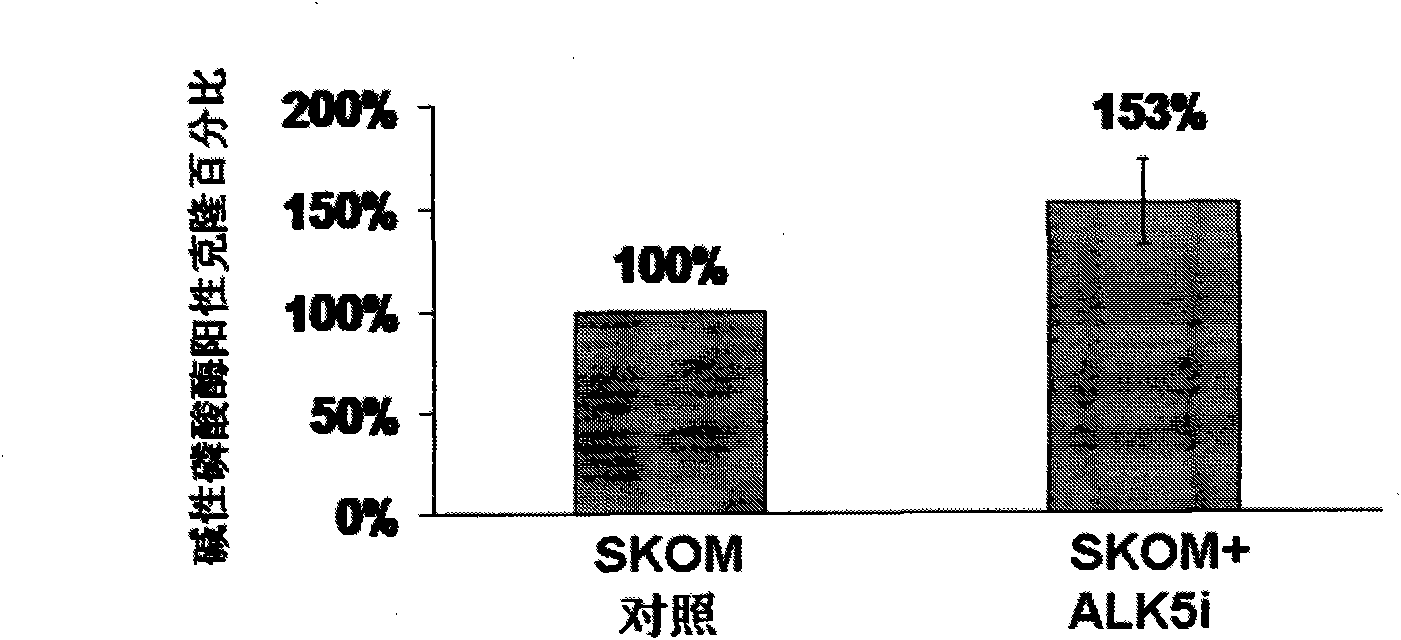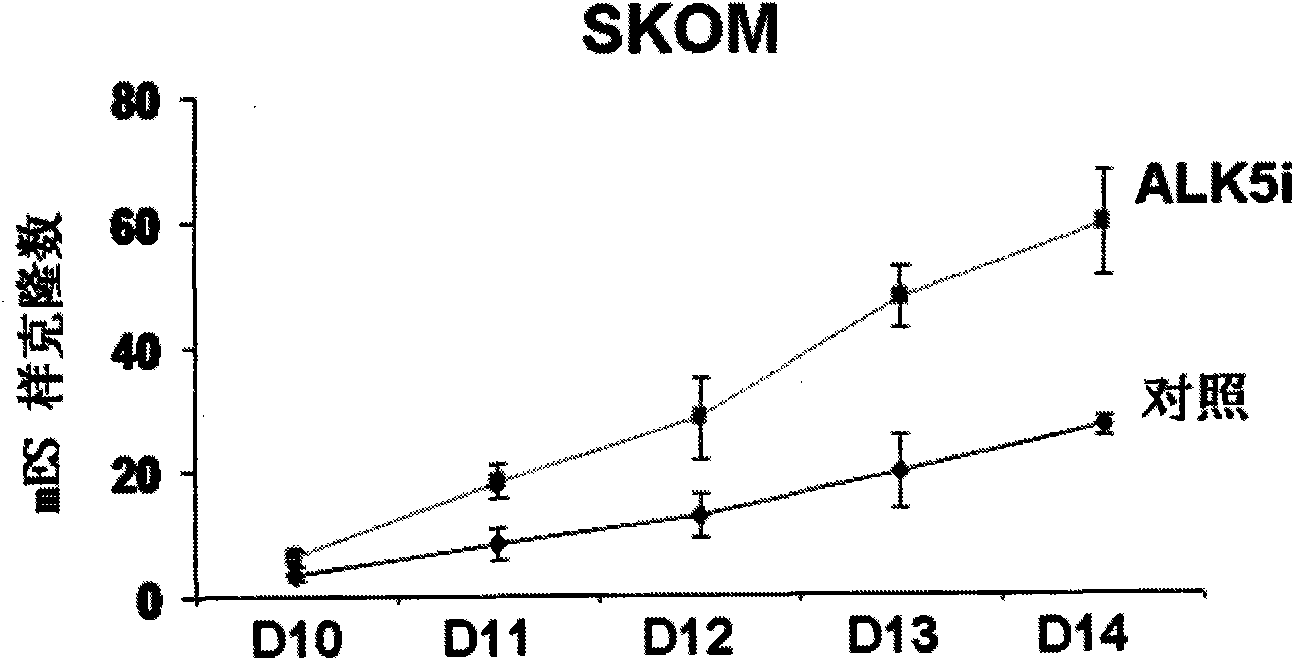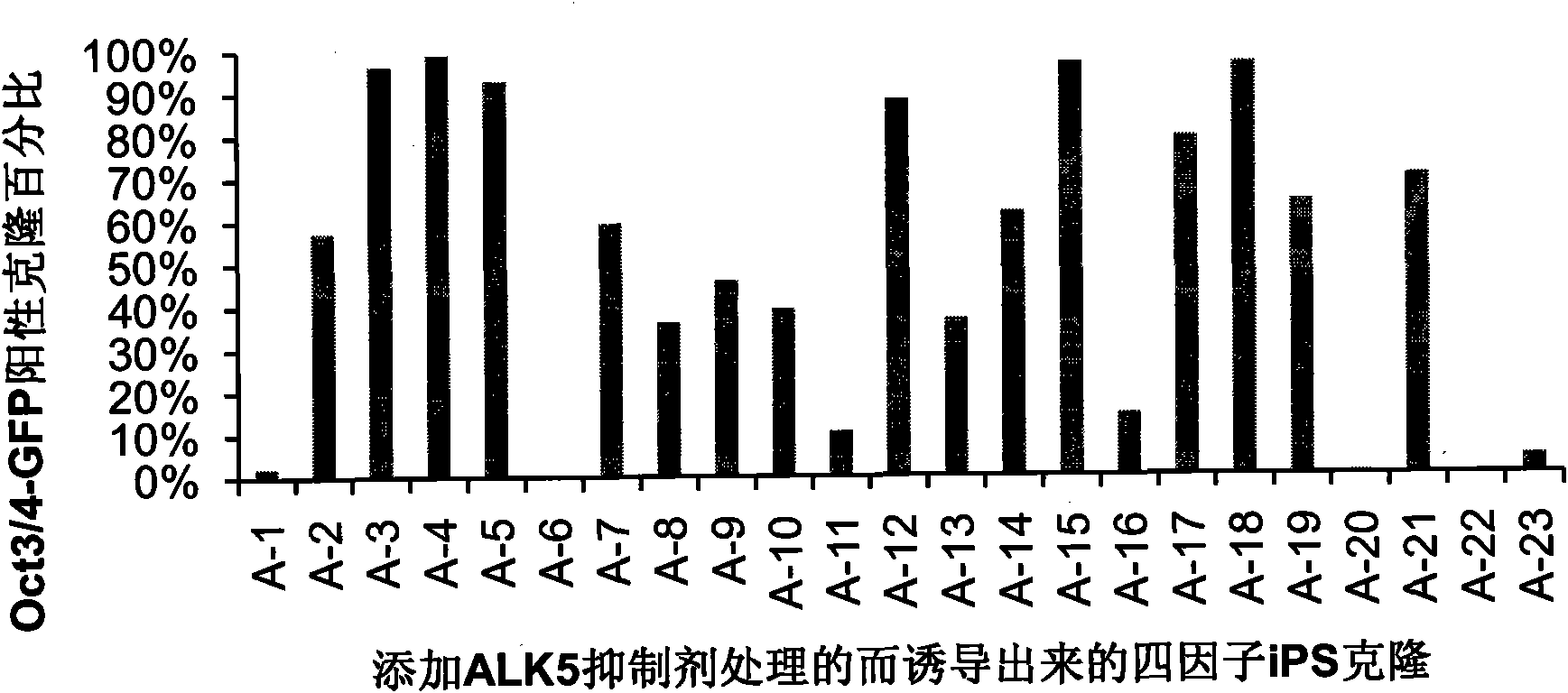Application of I type transforming growth factor receptor inhibitor in producing induced multi-potent stem cells and method thereof
A technology of transforming growth factor and pluripotent stem cells, applied in the field of culture of induced pluripotent stem cells, can solve the problem of low efficiency of iPS induction
- Summary
- Abstract
- Description
- Claims
- Application Information
AI Technical Summary
Problems solved by technology
Method used
Image
Examples
Embodiment 1
[0058] Example 1: Stem cell medium supplemented with ALK5 inhibitor can promote the formation of SKOM iPS
[0059] A. The virus of the four factors (SKOM) was mixed 1:1:1:1 (each 1ml) and infected into a total of 20,000 OG2 mouse embryonic fibroblasts (MEFs) in one well of a 12-well plate, And at 37 degrees, 5% CO 2 Cultured in mES medium (DMEM supplemented with 15% fetal bovine serum, 1000 U / ml leukemia inhibitory factor (LIF), penicillin / streptomycin, L-glutamine and non-essential amino acids). From day 3, add ALK5 inhibitor (A-83-01: 0.5 μM; LY-364947: 0.8 μM; SB-431542: 2 μM); on day 6, cells were digested with trypsin, counted, and inoculated 3000 Cells were pre-seeded with feeder cells (cultured in mouse embryonic fibroblasts treated with mitomycin (10 μg / ml)) in a 6 cm dish, and continued to be cultured with the addition of ALK5 inhibitor or solvent control; in Fourteen days later, alkaline phosphatase staining was performed and the number of AP-positive clones was co...
Embodiment 2
[0063] Example 2: Adding ALK5 inhibitor stem cell medium to promote the formation of SKO iPS
[0064] A. Infect a total of 20,000 mouse embryonic fibroblasts (MEFs) in a well of a 12-well plate after the viruses of the three factors (SKO) were mixed 1:1:1 (each 1ml), and at 37 degrees, 5% CO 2 cultured in mES medium. From day 3 onwards, ALK5 inhibitor or solvent control was added; on day 9, cells were digested with trypsin, counted, and 6000 cells were inoculated on feeder layer cells (cultured with mitomycin (10 μg / ml ) treated mouse embryonic fibroblasts) in a 6 cm dish, continue to use the addition of ALK5 inhibitor or solvent control to culture; count the number of Oct3 / 4-GFP positive clones under a fluorescent microscope on the 25th day, and carry out Alkaline phosphatase staining and counting the number of AP positive clones. Such as figure 2 As shown in a, compared with the control group, the addition of ALK5 inhibitors can increase the number of SKO-induced AP-pos...
Embodiment 3
[0066] Example 3: Identification experiment of pluripotency of induced pluripotent stem cell (iPS) cell line obtained by adding ALK5 inhibitor
[0067] A. As mentioned above, fibroblasts were infected with 3 factors, and then they were cultured in mES medium supplemented with ALK5 inhibitors. On day 25 after infection, representative ones were selected according to the clone morphology and fluorescence expression After several generations of stable passage, a uniform iPS cell line was formed.
[0068] Such as Figure 3a As shown, the left panel is a normal embryonic stem cell, and the right panel: the above-mentioned iPS cell line. These cell lines are morphologically very similar to embryonic stem cells and strongly express the green fluorescence of Oct3 / 4-GFP.
[0069] B. Before RNA purification, feeder cells were removed and uploaded on 0.2% gelatin for 2 passages. Total RNA was extracted using Trizol (Takara) reagent according to the manufacturer's instructions. Carry ...
PUM
 Login to View More
Login to View More Abstract
Description
Claims
Application Information
 Login to View More
Login to View More - R&D
- Intellectual Property
- Life Sciences
- Materials
- Tech Scout
- Unparalleled Data Quality
- Higher Quality Content
- 60% Fewer Hallucinations
Browse by: Latest US Patents, China's latest patents, Technical Efficacy Thesaurus, Application Domain, Technology Topic, Popular Technical Reports.
© 2025 PatSnap. All rights reserved.Legal|Privacy policy|Modern Slavery Act Transparency Statement|Sitemap|About US| Contact US: help@patsnap.com



